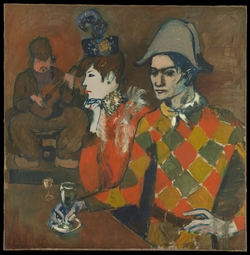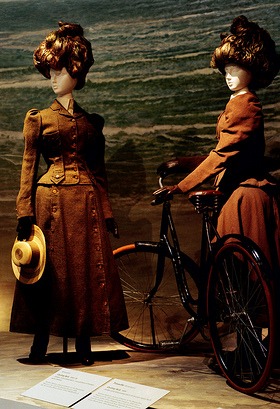 Late today, the Metropolitan Museum* put out a press release about its summer with some pretty impressive numbers, starting with a really big one: its three key summer exhibitions generated $784 million in economic activity by regional, national, and international tourists to New York, according to the museum’s visitor survey.
Late today, the Metropolitan Museum* put out a press release about its summer with some pretty impressive numbers, starting with a really big one: its three key summer exhibitions generated $784 million in economic activity by regional, national, and international tourists to New York, according to the museum’s visitor survey.
I had to read the release twice to make sure the decimal point wasn’t misplaced. It made more sense when you hear attendance:
Picasso in The Metropolitan Museum of Art, on view from April 27 through August 15, 2010, drew 703,256 visitors. (Au Lapin Agile is at left.)
Doug + Mike Starn on the Roof: Big Bambú, shown from April 27 through October 31, 2010, attracted 631,064.
American Woman: Fashioning a National Identity, on view from May 5 through August 15, 2010, drew 335,759 visitors.
All told, “using the industry standard for calculating tax revenue impact, the study noted that the direct tax benefit to the City and State from out-of-town visitors to the Museum totaled some $78.4 million,” the Met said.
A few more tidbits from the study:
- 72% of the Met’s summer visitors traveled from outside the five boroughs of New York.
- Of them, 46% were international visitors.
- 79% of travelers reported staying overnight in NYC, and 72% of these visitors stayed in a hotel or motel. The median length of stay was five nights.
- These visitors reported spending an average $1,050 per person ($696 for lodging, dining, sightseeing, entertainment, and admission to museums, and another $354 for shopping) during their stay in New York.
- 47% of travelers cited visiting the Met as a key motivating factor in visiting New York.
- On a scale of 1 to 10, 28% of visitors surveyed said that, in their decision to visit NYC, seeing one or more of the three exhibitions was an 8 or higher.
- 47% gave a rating of 8 or higher to visiting the Metropolitan Museum in general.
- During their stay, 73% visited other museums, 46% saw a Broadway show, and 16% attended an opera, ballet or a concert.
- The median age for visitors surveyed was 48, with 39% over 55. More than half (53%) held a master’s degree or higher.
- The median reported income was $79,000; 37% had income over $100,000.
 The museum did not provide comparable figures from the past, because its studies in the past covered only one or two exhibitions. In 2007, for example, its study assessed the economic impact of Cézanne to Picasso: Ambroise Vollard, Patron of the Avant-Garde and Americans in Paris, 1860-1900, which ran concurrently, and came up with the number of $377 million for economic impact.
The museum did not provide comparable figures from the past, because its studies in the past covered only one or two exhibitions. In 2007, for example, its study assessed the economic impact of Cézanne to Picasso: Ambroise Vollard, Patron of the Avant-Garde and Americans in Paris, 1860-1900, which ran concurrently, and came up with the number of $377 million for economic impact.
This summer was obviously stronger in exhibits. Interestingly, two of the three were completely or mostly drawn from the museum’s collections and Big Bambu was a site-specific commission. They therefore presumably cost less (no added insurance, shipping, etc.).
I commend the Met for sharing this information. Of course, it had a point to make, which is that the museum contributes more to the city’s economy than it gets in aid. Good point — one that many people don’t know.
Another little flaw: the survey sample is quite small: 618. And the museum didn’t share its methodology.
Nonetheless, it’s something — as I have said many times, the art world needs more and better statistics.
Photo Credits: Courtesy of the Metropolitan Museum
*I consult to a foundation that supports the Met.
